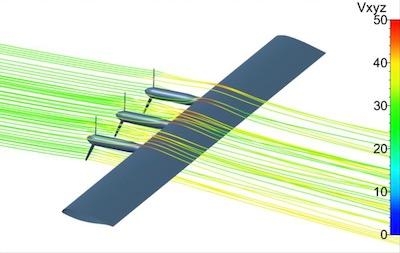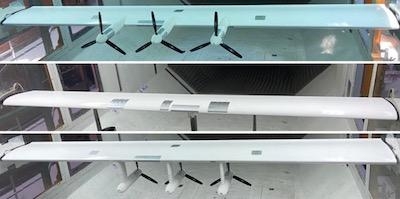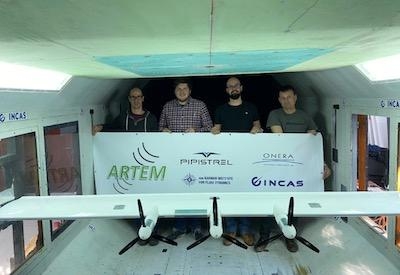Aircraft Noise Reduction Technologies And Related Environmental iMpact Studies Aircraft Configurations
Pipistrel is a project partner in the ARTEM project (Aircraft noise Reduction Technologies and related Environmental iMpact) that aims at the maturing of promising novel concepts and methods which are directly coupled to new low noise and disruptive 2035 and 2050 aircraft configurations.

Last week, members of Pipistrel Vertical Solutions (PVS) research have just returned from a week long wind tunnel testing in INCAS, Bucharest. The team was performing tests on a composite design model wing with modular attachment points for different Distributed Electrical Propulsion (DEP) configurations, designed and built by PVS within the ARTEM European project.
ARTEM is a four-year European Union‘s Horizon 2020 research project devoted to the development of novel noise reduction technologies for low-noise 2035 and 2050 aircraft configurations.
PVS involvement in the ARTEM project is on the investigation of novel DEP aircraft configurations, whose global objective is the investigation and mitigation of noise emissions of DEP systems. Together with three ARTEM partners, VKI, ONERA and INCAS, PVS explored two different configurations of such integration. The mock-up is composed out of the main wing and three propellers positioned in front of the wing, resulting in the 'tractor configuration', or on top of the wing, resulting in the 'pusher configuration'.

PVS worked on the general definition of the DEP mock-up, defining all necessary functional requirements for the experiment. The conceptual and preliminary design phases followed with the selected concept having a modular design allowing for spanwise, chordwise and vertical positioning of the propellers in both configurations. An aerofoil profile, especially suited for DEP systems, was carefully designed. During the preliminary and detailed design phases a thorough numerical assessment of the DEP wing and subsystems was done using RANS/URANS CFD. In the detailed design phase, PVS finished the geometry and dimensioned the structure to withstand the loads imposed in the wind tunnel with minimal deflections. The wing shell and main spar were dimensioned to have less than 2 mm deflection on a 100-inch span in the nominal 30m/s loading condition at maximum AoA. The structure was also tested numerically with FEM, which predicts a factor of safety of 30 in the nominal design case.
Once the design was frozen, PVS finished the complete technical documentation for the moulds, integral wing parts and modules. The model wing was produced to the highest production standards using modern manufacturing technologies. Innovative production solutions were developed when facing very limited space within a 12-inch chord and merely 2-inch maximum thickness of the cross section. The mock-up seamlessly combines composite, aluminium and 3D printed parts in order to ensure quality and technical excellence while retaining a competitive price.
Finally, PVS operated the mock-up during the wind tunnel tests at INCAS to speeds up to 97 knots. Both configurations were successfully tested at INCAS wind tunnel in order to identify the noise sources and their relative weights between the wing and propeller regions, and between the tonal and broadband contributions. Experimental data will be at great help to the task partners to analyze parametric sensibilities of the noise in order to identify parameters of interest for acoustic reduction.

DEP type of propulsion became feasible with the introduction of state-of-the-art electric motors and offers numerous potential noise reduction configurations. It offers more degrees of freedom during the integration of a propulsion system on an aircraft. This is why PVS is heavily invested in facilitating research of such topics through implementing our broad spectre of knowledge and experience to bring ideas to life in a very fast cycle.
Most favorable configuration with respect to the acoustic and aerodynamic performance will be selected by PVS at the end of the project, and full recommendations for designing the state-of-the-art DEP system will be provided.
(Source: Pipistrel news release. Images provided)
 Aero-FAQ: Dave Juwel's Aviation Marketing Stories -- ITBOA BNITBOB
Aero-FAQ: Dave Juwel's Aviation Marketing Stories -- ITBOA BNITBOB NTSB Prelim: Rutan Long-EZ
NTSB Prelim: Rutan Long-EZ ANN's Daily Aero-Term (12.05.25): Hazardous Weather Information
ANN's Daily Aero-Term (12.05.25): Hazardous Weather Information Aero-News: Quote of the Day (12.05.25)
Aero-News: Quote of the Day (12.05.25) Airborne-Flight Training 12.04.25: Ldg Fee Danger, Av Mental Health, PC-7 MKX
Airborne-Flight Training 12.04.25: Ldg Fee Danger, Av Mental Health, PC-7 MKX





